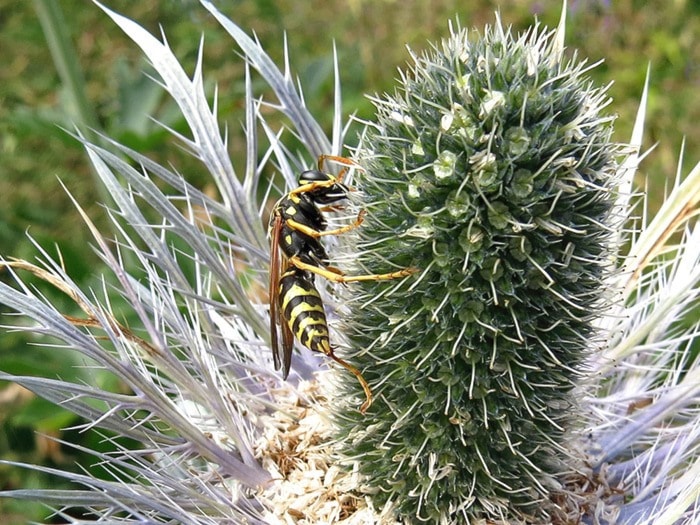Have been overwhelmed by the number of bees in our pond lately. Dozens and dozens of them. Not surprising I guess in this heat. Humans are not the only critters who need to stay hydrated.
When I said bees by the way, I specifically meant European paper wasps. They are by far the majority species concentrating on drinking our pond dry.
European paper wasps, or more correctly, Polistes dominula, look very much like our native yellow jacket and hornet species. It has a black body with yellow markings. The distinguishing feature is its narrow waist between thorax and abdomen. If seen side by side, yellow jackets and hornets have a somewhat blunter body shape than European paper wasps. A further identifying clue is the long dangling legs of the European species when in flight.
Another difference between these black and yellow-striped species is the European paper wasp's non-aggressive tendencies. They are less likely to sting than yellow jackets, hornets and even bumblebees unless you stumble into their nest accidentally.
Originally native to southern Europe, North Africa and parts of Asia, this bee was first reported in New Jersey in 1968. From there it expanded into Boston in 1970, Wisconsin and Virginia in early 1980, Michigan in 1994, Ontario in 1997 and Colorado in 2001. This wasp then simultaneously moved east and west to Nova Scotia and British Columbia in 2003.
By 2008 the European paper wasp could be found in most regions across North America. It has settled in Australia, Chile and Argentina, too.
Once the queen, or foundress, has mated in the fall, she will hibernate through the winter in a sheltered location. Come spring, nest building begins. Selecting the eave of a house or an out-of-the-way cavity, the queen fashions a short stalk, or petiole, with a single brood cell at the end of it. More cells are added to it laterally in a hexagonal pattern, each cell surrounded by six others.
Where these nests differ from those built by yellow jackets and hornets is they remain open; the cells are not encased in football-shaped domes of paper.
The queen deposits an egg in each brood cell as it is constructed. When the larvae hatch, they are fed a diet of regurgitated insects, usually caterpillars. Often two to six auxiliary queens join the original queen and help with feeding the larvae and building brood cells. While these subordinate queens maintain a submissive position in the hierarchy of the nest, they are not above trying to sneak in one or two of their own fertilized eggs that the queen usually finds and destroys.
When the larvae reach full size they seal over their own cells to pupate. Full cycle from egg to adult takes between four and five weeks. This first seasonal brood of wasps are all females destined to be workers, taking over the foraging for and caring of the young larvae as well as continually adding more brood cells to the nest. By the end of the season there are usually several dozen wasps in the colony, with some reports of as many as 200.
Towards late summer males are produced along with reproductive females destined to become queens for next year's colonies. Both leave the nest on mating flights before the females seek a winter shelter and the males perish.
Many entomologists classify Polistes dominula as an invasive species while organic farmers hail them as beneficial. Their diet consists mainly of caterpillars, both pest and beneficial. (Hopefully mainly tent caterpillars!)
As the European paper wasp is non-aggressive...even leaving you alone to enjoy your summer meals outside...you can practice a live and let live co-existence. If the nest is an inconvenience, you can destroy it in the same manner as you would treat a hornet's nest.
Leslie Cox co-owns Growing Concern Cottage Garden in Black Creek. Her website is at www.duchessofdirt.ca and her column appears every second Thursday in the Record.
